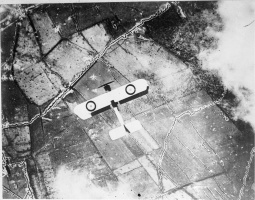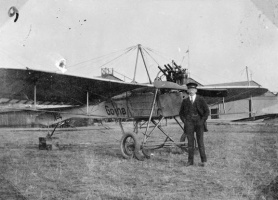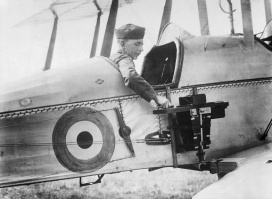Reconnaissance Aircraft at the Start of the War↑
By September 1914, aircraft were the primary means of collecting army intelligence. By 1918, all commanders relied on aerial reconnaissance before they initiated operations. Thus, it was essential at the tactical, operational, and strategic levels of war.
Both the French and the German armies introduced aircraft into their 1911 military maneuvers. The French had firmly incorporated aerial reconnaissance into their army, codifying reporting practices, aerial navigation, and target location. They developed ways to tow aircraft in bad weather and employed mobile repair shops. When World War One began, France had approximately 141 reconnaissance airplanes, while Germany had about 295 aircrafts. Britain sent four squadrons of roughly fifty observation planes to France with the British Expeditionary Force (BEF).
From the beginning of the war, aircraft did very well observing on both fronts. On the Western Front, German, French, and BEF airplanes accurately kept commanders abreast of enemy maneuvers in the war’s opening phases. By the end of August 1914, the airplane was no longer an auxiliary means of information, but rather the principal means by which armies received their operational reconnaissance, mainly because in about an hour or two, aircraft could reconnoiter an area and accurately report their findings back to the commander, whereas a cavalry report might take a day or two to reach headquarters.
The speed of aerial reconnaissance in 1914 proved critical, since commanders received accurate hourly reports that denied armies the strategic surprise necessary to flank and defeat their foe. Aerial reconnaissance may have resulted in the war becoming a stalemate. During the so-called “Race to the Sea,” neither side was able to gain a decisive advantage since mobility stopped and soldiers dug into the earth to escape the mechanized weaponry, resulting in a series of trenches extending some 700 kilometers from the Swiss border to the North Sea. During the Battle of Tannenberg, the German army masterfully employed aerial reconnaissance to quickly advise commanders of Russian troop movements while the Russian commanders were hobbled with traditional cavalry reconnaissance, which took much longer.
Photography, Balloons, and Technical Innovation↑
An army’s traditional eyes and ears, the cavalry, could not penetrate enemy trenches. Only the fragile airplane crossed the lines unscathed, and when mated with the camera brought back indispensable information. Aerial reconnaissance was almost “real time” intelligence for Great War commanders and also led to improved photographic technologies. Intelligence officers covered headquarters walls with photographic mosaics of the battlefield, which they studied and compared with new photos delivered by aerial reconnaissance, noting any changes.
Accurate aerial reconnaissance warned armies of impending offensives, kept leaders apprised of the position of friendly troops in what were called “contact patrols,” and were adapted to control artillery fires. Both aircraft and kite balloons performed such missions. Balloon observers used telephones connected to headquarters to immediately report information. When weather was poor, they could float just below the cloud deck and still report efficiently.
Although balloons were effective, their range was limited. Using wireless, aircraft could direct artillery fires about 20 kilometers behind the front (the limit of most heavy artillery). Eventually, reconnaissance aircraft penetrated 80-90 kilometers behind enemy lines flying above 6,000 meters, often as a formation of three for mutual support—both for photographic coverage and fire support from hostile aircraft. Some reconnaissance aircraft carried oxygen to allow the crew to fly long distances at high altitude and not suffer the effects of hypoxia.
Pursuit Planes and Zeppelins↑
Commanders needed friendly reconnaissance and sought to deny their enemy such intelligence. Thus emerged the “pursuit” or fighter plane, which attacked enemy observation aircraft and sought to protect friendly reconnaissance aircraft from hostile pursuit attacks. Whichever side controlled the skies dominated reconnaissance and the intelligence it provided. The subsequent battle for command of the air and rapid evolution of improved aircraft technology resulted from the reconnaissance mission.
Besides land-based aircraft, naval services used float planes and dirigibles for reconnaissance. The German navy initially used Zeppelins as fleet scouts. Later they bombed Britain, but Zeppelins also carried cameras and conducted strategic reconnaissance of the British Isles on many of these missions.
Charles Dusch, United States Air Force Academy
Section Editor: Mark E. Grotelueschen
Selected Bibliography
- Finnegan, Terrence J.: Shooting the front. Allied aerial reconnaissance and photographic interpretation on the Western Front, Washington, D.C. 2006: National Defense Intelligence College Press.
- Morrow, Jr., John Howard: The Great War in the air. Military aviation from 1909 to 1921, Washington, D.C. 1993: Smithsonian Institution Press.
- Neiberg, Michael: Fighting the Great War. A global history, Cambridge 2005: Harvard University Press.
- Rickenbacker, Eddie: Fighting the flying circus, Garden City 1965: Doubleday & Co..












